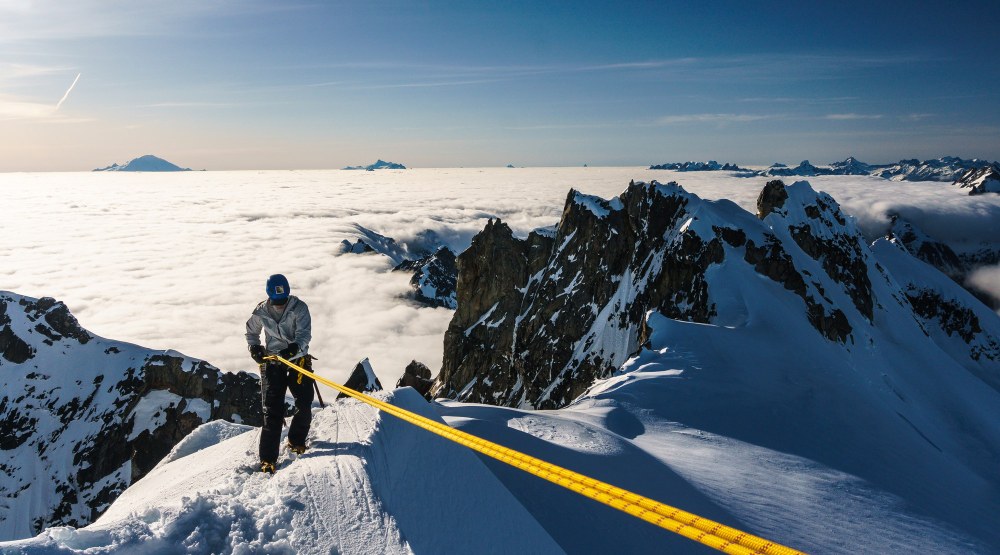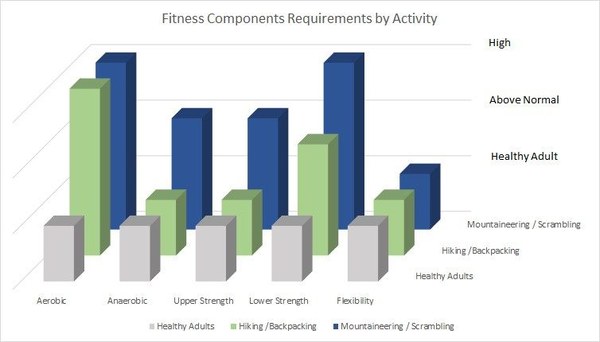
With summer around the corner, it’s time to train for upcoming outdoor goals. In this edition of Peak Performance, I hope to help you assess the components of your alpine sport, and describe how to put together a safe, suitable, and personalized training program.
Training components at a glance
The figure “Fitness Elements by Activity” (below) illustrates the degree to which different sports require a greater-than-average level of fitness in five key areas: aerobic, anaerobic, upper body strength, lower body strength, and flexibility. As you can see, aerobic needs are high for mountaineers, scramblers, and hikers, and flexibility needs are around what the average healthy adult has. However, mountaineers need to be comfortable carrying a heavy backpack for hours over varied terrain, and will need an above-normal or high amount of lower body strength. People engaged in mountaineering, climbing, or scrambling activities also need to include more anaerobic and upper body strength training than hikers. In short, if your current fitness program consists primarily of walking, running, or biking, and you want to be adequately prepared for the rigors of alpine travel, adding pack-carrying and strength training several times a week can help you be much better prepared for a satisfying summer season.
Fitness Elements by Activity
Evaluate yourself
Once you have a training objective, figure out your starting point so that you can map out small, safe increments to reach your goal. For mountaineers in the greater Seattle area, Tiger Mountain (six miles and 2000’ gain) and Mt. Si (eight miles and 3400’ gain) make great repeatable benchmark hikes against which you can compare your times to make sure your program is working. If you get faster, go farther, have less soreness, or carry more weight in the same amount of time as earlier, your program is working.
The biggest mistakes we see people make include carrying too much weight on their first hike of the season or trying to go too far. Unless you’ve consistently hiked several times per month through the winter, don’t try to do whatever you did last season. Go light and short. You can always add weight or distance on the next trip. Be honest with yourself about how you feel, where you feel weak or slow, and what feels good, so that you don’t waste time where you’re already competent. Focus on fixing weaknesses first.
If you have knee issues on the descents, you may want to strengthen the quadriceps. If you can run six miles in under an hour, but carrying a pack slows you way down, add exercises for the hamstrings, glutes, and core, and consider a mid-week pack-carrying session. If your hips ache during or after a hike, add hip stretches to increase your mobility.
Set mini-goals
If you have three months before your first trip, set short-term goals for one and two months from now. If you plan on doing some backpacking or multi-day trips, include back-to-back training days (i.e. successive pack-carrying days with no rest day between) at the ten week mark. Mini-goals will keep you motivated, train you physically and psychologically, and provide you with valuable feedback so that you can adjust your training program. Short-term goals also give you good benchmarks for when to change variables in your program.
Develop building blocks
We like to recommend building a firm foundation, increasing sport-specific strength, and improving your stamina and mental toughness when you’re training for an upcoming season.
In the first month, focus on perfecting your form while training with unilateral free-weight exercises (single limb movements such as dips, lunges, step-ups and downs, one arm rows, and presses) to make sure both sides of the body are working evenly. 2-3 sets of 8 exercises for 8-10 repetitions twice a week should suffice.
In the second month, build as much sport-specific strength as possible, doing 3-4 sets of 6-8 repetitions of 8-10 multi-joint or compound exercises. This might include pushups, deadlifts, squats, bench presses, or pull-ups. Try to increase the difficulty of each workout in some way, so that you make steady progress instead of repeating the same workout throughout the month.
In the third and final month of training, focus on building stamina by using lighter weights with higher repetitions and shorter rests. This might mean 2-3 sets of 10 exercises, with 12-15 repetitions each with very short rests between sets, moving fluidly from one exercise to the next.
Include additional training
In addition to general cardiovascular, strength, and flexibility training, a well-balanced program will also include sport-specific training and skills development.
Sport-Specific: If you do scrambling or mountaineering, this means finding a way to travel uphill carrying a pack. You can go up and down stairs or short hills, or use an incline treadmill, stairclimber, or elliptical machine. Plan to increase your pack weight, duration (time or mileage), or speed by no more than 10% per week. This will provide sport-specific conditioning that cannot be matched by any other training.
Skills: If your sport requires specific skills, plan to devote time to review, develop, and maintain them. For hiking, backpacking, and trekking, such areas might include traveling over challenging terrain, navigation with a map and compass, first aid, and general wilderness skills. For mountaineering and scrambling, this may also include ice axe arrest, rope handling skills, rest step, pressure breathing, and crevasse rescue practice.
Prioritize building blocks
How do you know what is most important? If you run five days a week, you may benefit from reducing the number of times you run, adding a pack workout, and adding two strength training workouts. If you train in the gym four times a week, you may need to schedule time for aerobic training and pack-carrying outside. And if you hike three days a week but you are stiff all the time and feel weak, then you might want to replace one of your weekly hikes with some strength training and mobility training. Train smarter, not necessarily more.
With larger training cycles now in place, you’re ready to create a weekly program. The highest priority for any alpine training plan is hiking-specific training to build aerobic stamina, lower body strength, and wilderness skills simultaneously. Walk uphill with a pack a few times each week. One day may include a multi-hour hike, perhaps on weekends when you have more time available to train. The other might be a shorter local hill walk, or training on an incline machine, with a pack. If you are planning a multi-day trip, be sure to train with a pack on successive days once or twice before your trip.
With some planning and special attention to where you know you need help, you can craft a program that will prepare you for your alpine adventures. If you have questions, feel free to email me at court@bodyresults.com. I want you to succeed and enjoy your trips into the wilderness.
This article originally appeared in our Spring 2021 issue of Mountaineer Magazine. To view the original article in magazine form and read more stories from our publication, visit our magazine archive.
 Courtenay Schurman
Courtenay Schurman
